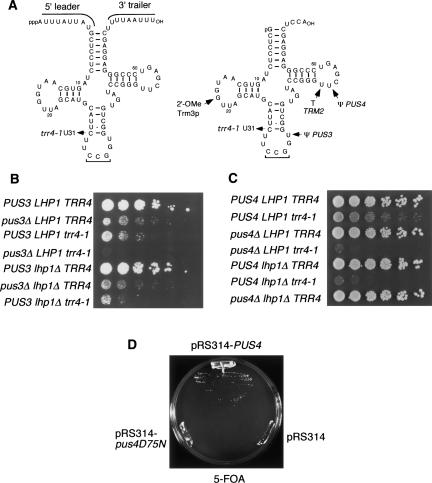FIGURE 3.
Yeast cells containing the trr4-1 mutation require PUS3 and PUS4 for efficient growth. (A) Secondary structures of pre-tRNACCGArg (left) and mature tRNACCGArg (right) are shown. The position of the trr4-1 mutation is indicated, as are the potential sites of modification by TRM2, TRM3, PUS3, and PUS4. (B) Serial dilutions of wild-type cells (PUS3 LHP1 TRR4), cells lacking Pus3p (pus3Δ LHP1 TRR4), trr4-1 cells (PUS3 LHP1 trr4-1), trr4-1 cells lacking Pus3p (pus3Δ LHP1 trr4-1), cells lacking Lhp1p (PUS3 lhp1Δ TRR4), cells lacking Pus3p and Lhp1p (pus3Δ lhp1Δ TRR4), and trr4-1 cells lacking Lhp1p (PUS3 lhp1Δ trr4–1) were spotted on YPD agar and grown at 25°C. (C) Serial dilutions of wild-type cells (PUS4 LHP1 TRR4), trr4-1 cells (PUS4 LHP1 trr4-1), cells lacking Pus4p (pus4Δ LHP1 TRR4), trr4-1 cells lacking Pus4p (pus4Δ LHP1 trr4-1), cells lacking Lhp1p (PUS4 lhp1Δ TRR4), trr4-1 cells lacking Lhp1p (PUS4 lhp1Δ trr4-1), and cells lacking Pus4p and Lhp1p (pus4Δ lhp1Δ TRR4) were spotted on YPD agar and grown at 25°C. (D) Plasmids containing PUS4 or pus4[D75N] in the low copy vector pRS314 were introduced into pus4Δ lhp1Δ trr4-1 cells carrying PUS4 in the URA3-containing pRS316 vector. As a control, the strain was also transformed with the pRS314 plasmid. Transformants were streaked on 5-FOA-containing medium and grown at 25°C.

